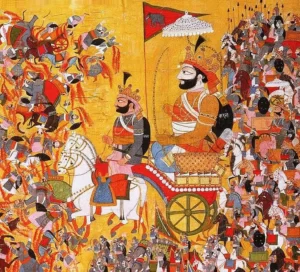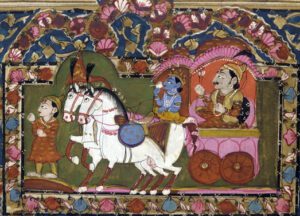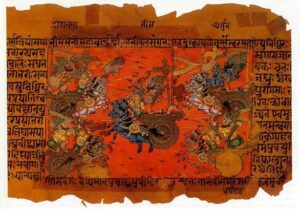History and Learnings from Mahabharata
The Mahabharata is an ancient Indian epic that tells the story of the legendary conflict between two branches of a royal family, the Kauravas and the Pandavas, for the throne of the kingdom of Hastinapura. The story centers on the Pandava brothers, who are the five sons of Pandu, the king of Hastinapura, and their struggle for the throne against their cousins, the Kaurava brothers, who are the one hundred sons of Pandu’s older brother, Dhritarashtra.
The story begins with the birth of the Pandava brothers, who are the offspring of Pandu’s two wives, Kunti and Madri. Despite the fact that Pandu is cursed and unable to father children, Kunti uses a magical boon given to her by the sage Durvasa to bear five sons, who are each fathered by a different god. The five brothers are named Yudhishthira, Bhima, Arjuna, Nakula, and Sahadeva.
Meanwhile, Dhritarashtra, who is blind, fathers one hundred sons through his wife, Gandhari. These sons are known as the Kauravas, and the eldest of them is Duryodhana. From a young age, Duryodhana is envious of the Pandava brothers and their superior abilities, and this jealousy only grows stronger as they grow older.
As the Pandavas come of age, they are forced to flee from Hastinapura after Duryodhana, who has been appointed as the crown prince, plots to kill them. The Pandavas take refuge in the kingdom of Panchala, where they marry the Panchala princesses Draupadi, Subhadra, and Ulupi.
After many years of exile, the Pandavas return to Hastinapura and claim their rightful place on the throne. However, Duryodhana, who has become the king in their absence, refuses to give up his power. The two sides engage in a series of negotiations and attempts at peace, but ultimately the dispute leads to a great war between the Kauravas and the Pandavas, known as the Kurukshetra War.

The Kurukshetra War is fought for eighteen days, with the Pandavas emerging victorious. However, the war takes a heavy toll on both sides, with many great warriors and kings being killed. In the end, only five Pandavas and one Kaurava, Ashwatthama, survive the war.
After the war, the Pandavas return to Hastinapura and rule the kingdom justly, bringing peace and prosperity to their people. However, their story does not end happily, as they are eventually betrayed by their own cousin and forced to renounce their kingdom and embark on a journey of spiritual redemption.
The Mahabharata is a complex and sprawling epic that explores themes of duty, loyalty, and the consequences of war. It is considered one of the greatest works of Indian literature and is a key text in Hinduism.

Learnings from Mahabharata – 10 points
- The importance of dharma and righteousness: The Mahabharata emphasizes the importance of upholding dharma and righteousness in all aspects of life. This is demonstrated through the actions of many of the main characters, including Yudhishthira, who is known for his adherence to dharma, and Bhishma, who is known for his unwavering commitment to righteousness.
- The consequences of adharma and unrighteousness: The Mahabharata also illustrates the negative consequences of adharma and unrighteousness. This is seen in the actions of characters like Duryodhana, who is known for his greed and desire for power, and Drona, who is known for his loyalty to the wrong cause.
- The value of wisdom and knowledge: The Mahabharata emphasizes the importance of wisdom and knowledge, and the role they play in decision-making and achieving success. This is demonstrated through the actions of characters like Yudhishthira, who is known for his wisdom and intelligence, and Krishna, who is known for his knowledge and guidance.
- The importance of family and relationships: The Mahabharata highlights the importance of family and relationships, and the role they play in shaping one’s identity and values. This is seen in the relationships between the Pandavas and Kauravas, who are cousins and enemies, as well as in the relationships between the Pandavas and their mothers, wives, and children.
- The dangers of ego and pride: The Mahabharata illustrates the dangers of ego and pride, and how they can lead to destruction and conflict. This is seen in the actions of characters like Duryodhana, who is known for his arrogance and pride, and Drona, who is known for his desire for recognition and power.
- The importance of self-control and discipline: The Mahabharata emphasizes the importance of self-control and discipline, and how they are essential for achieving success and happiness. This is demonstrated through the actions of characters like Arjuna, who is known for his self-control and discipline, and Yudhishthira, who is known for his self-restraint and determination.
- The role of fate and destiny: The Mahabharata explores the role of fate and destiny in one’s life, and how they can influence one’s actions and decisions. This is seen in the story of the Pandavas, who are destined to win the war, and in the story of Krishna, who is destined to play a crucial role in the war.
- The importance of sacrifice and selflessness: The Mahabharata highlights the importance of sacrifice and selflessness, and how they are essential for achieving success and happiness. This is demonstrated through the actions of characters like Bhishma, who is known for his selflessness and sacrifice, and Draupadi, who is known for her loyalty and devotion to her family.
- The power of friendship and loyalty: The Mahabharata explores the power of friendship and loyalty, and how they can be a source of strength and support in difficult times. This is seen in the relationships between the Pandavas and their allies, who are loyal and supportive of each other, and in the relationship between Krishna and Arjuna, who are close friends and allies.
-
The importance of honor and integrity: The Mahabharata emphasizes the importance of honor and integrity, and how they are essential for upholding dharma and righteousness. This is demonstrated through the actions of characters like Bhishma, who is known for his honor and integrity, and Arjuna, who is known for his skills.

Image Credits – Wikipedia
Learnings from Mahabharata – 10 points
If you are interested, you should also read Learnings from Bhagavad Gita











